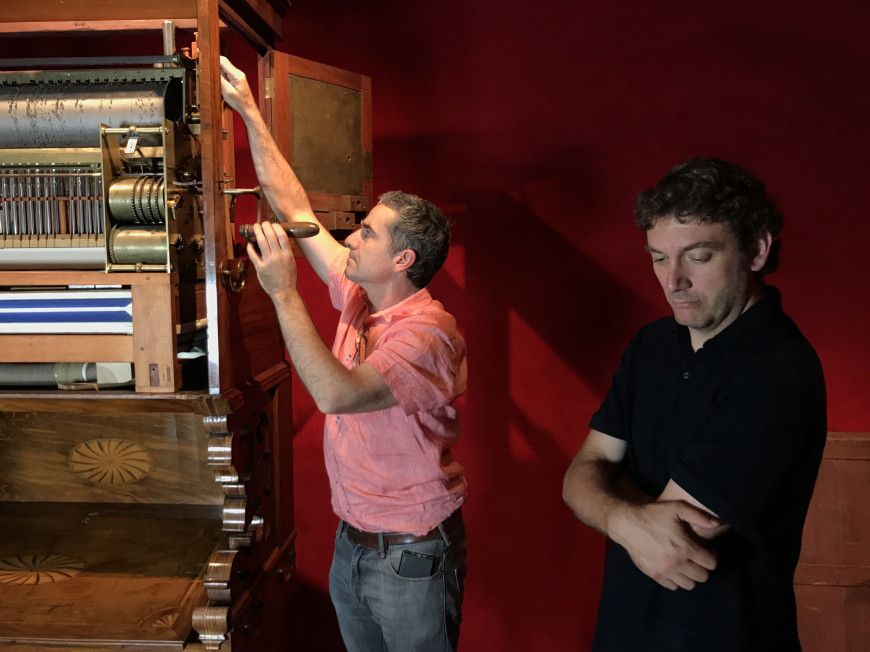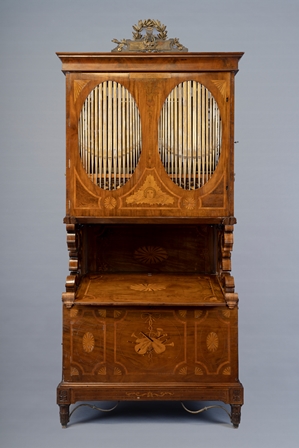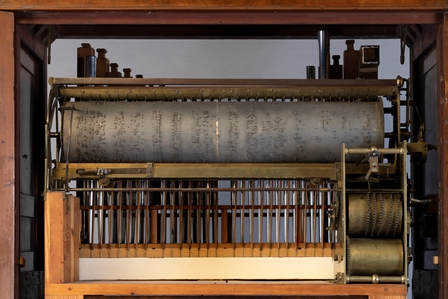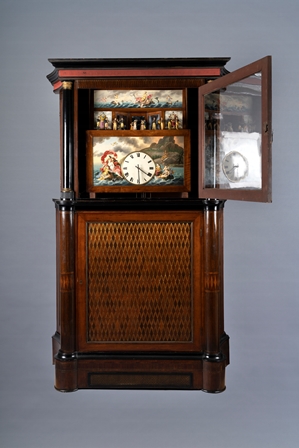
Research projects
The Evans' barrel organ
One of the museum's functions, besides preserving and displaying the pieces it safeguards, is to research in order to explain what they are, how they were used or are still used, who their owners were, their era, the places where they have been, etc. This information obtained from research is made available to the public through the labels in the museum's exhibitions. If the information is more extensive, it is presented in room sheets, blog articles, specialized magazines, or books, such as the one we are now discussing.
When a new research project was launched, we opted to learn more about the Evans barrel organ (registration number MDMB 35), in order to explain to visitors why this writing desk is placed among other instruments like harmoniums, player pianos, and pianos.

Why is this piece of furniture, which looks more like a writing desk cabinet, relevant enough to be part of the permanent exhibition of the Museum of Music from Barcelona, if at first glance it only has pierced windows in the shape of organ pipes and marquetry inlays with musical instrument motifs?

Firstly, there is an inscription at the top of the piece that reads: "A Su Real Majestad don Carlos III 1762". In the journal Reales Sitios de Patrimonio Nacional, issue 97, the organologist Beryl Kenyon de Pascual, in an article about Carlos III, who she describes as a king who protected music, explains that Carlos III promoted the construction of a new instrument in Spain at that time: the barrel or clock organ. The article mentions that in 1762, the English clockmaker Diego Evans built, either by commission or as a gift, an impressive mechanical organ. Kenyon also highlights that there are no records of large-format barrel organs in Spain during the first half of the 18th century. However, after Evans' instrument arrived, these organs multiplied, being used both in churches and aristocratic salons, where they could replace dance orchestras.
We also have its registration number, MDMB 35, a number so low that it indicates it is one of the first objects cataloged when the museum was founded in 1943. Additionally, if we open the window representing the organ pipes, we can see a whole clockwork mechanism with a spiked roller and organ pipes at the back of the instrument. We are facing a mechanical musical instrument.
What is a mechanical instrument? A simple definition would be: an instrument that does not require a specialist to play it. While instruments such as the organ, guitar, or flute need a musician to play them with more or less skill, a mechanical instrument only requires winding up or pressing a button for it to start playing.

Since the invention of the first clock mechanisms with the technique of the spring and the escapement mechanism, which allows for the uniform and continuous release of energy and constant movement, humans have tried to adapt these systems to make bells ring and thus mark the hours. With the evolution of these systems, more devices and mechanisms could be attached to make bells, metal plates, or a spiked cylinder play one or several melodies at the right moment. By the late 19th century and early 20th century, the manufacturing of mechanical musical instruments was no longer artisanal, and industries were created to mass-produce these devices. When Thomas Alva Edison managed to record the voice on a wax cylinder and play it back, patenting the phonograph in 1877, mechanical instruments became more popular, though the production of cylinders was costly and not accessible to everyone. No longer was it only the upper bourgeoisie who could enjoy music at home. Years later, Emile Berliner did the same with a flat disc, inventing the gramophone. By making resin molds for copying discs, they could be mass-produced much more cheaply. The subsequent application of electricity to these devices meant that mechanical instruments made their way into nearly every household.
Currently, the museum holds around 300 mechanical musical instruments from all eras in its collections, many of which come from the acquisition of the Arellano Fund. The Barcelona City Council acquired this fund in 1970, which mainly consists of phonographs, gramophones, accessories, music boxes, dictaphones, and various documents on instruments. In Catalonia, we have documentation in our collections of up to fifteen companies that produced different types of mechanical instruments under various patents, including: Compañía Francesa del Gramófono, La Voz de su Amo, New Phono, Odeón, Hammond or Vanguard, based in Barcelona, and Arton, based in Cerdanyola del Vallès, which used asbestos (Uralita) to manufacture their devices. Another company was Industria Parlante Casa Morón, based in Lleida.
But what kind of instrument is the Evans? It is a mechanical instrument that we can classify as a crank organ or an aerophone with a spiked roller. We have thirteen of this type. In other annexes, we will explain how these mechanisms work.
During the research on this instrument, we discovered that, always as far as the documentation goes, it traveled accompanied by another object from the collection: the musical clock with registration number MDMB 36, which is in the museum's reserves. Among the museum's documentation, we have the entry records dated February 20, 1943, which indicate that both the Evans and the clock came from the Museums of Art of Barcelona. We also have the inventory records of the furniture and works of art of the Pedralbes Palace, made in 1931 when the Barcelona City Council confiscated the palace. We also have a copy of the minutes of the meeting in which the Museum Board requested the transfer of both instruments and decided that the objects would go to the Albéniz Pavilion in Montjuïc to be part of the new Museum of Ancient Musical Instruments that was being designed.


At the start of the research, these were the available pieces of evidence regarding the two instruments in the collection: furniture built for Carlos III in 1762, which was part of the furniture of the Pedralbes Palace until 1931, donated to the new museum in 1932, and entered into the museum in 1943. However, we asked ourselves how and when they arrived in Barcelona and what their history was before becoming part of the museum.
The research leads us to:
- The reign of Carlos III and his interest in music (let's remember that he commissioned the purchase of the five Stradivari: 2 violins, 2 violas, and a cello for his son Carlos IV, which are still preserved in the Palacio Real in Madrid).
- The reign of Carlos IV and the clockmakers of his chamber, with the appearance of the "cylinder makers."
- The French Revolution and the inclusion of Nicolas Jeandel as an author of the instrument.
- The Liberal Triennium and Absolutism during the reign of Ferdinand VII.
- A visit to the Güell Palace to see the relationship between the Güell family and the Spanish monarchy.
- The history of the Pedralbes Royal Palace and the Second Republic.
- Finally, we return to the starting point: the Spanish Civil War, when the creation of the Museum of Music was postponed. It was eventually inaugurated in 1943 in a wing of the second floor of the Barcelona Conservatory of Music, on Bruc Street, where both instruments are now part of the municipal collections.
We hope to see this great research soon published in a book.

